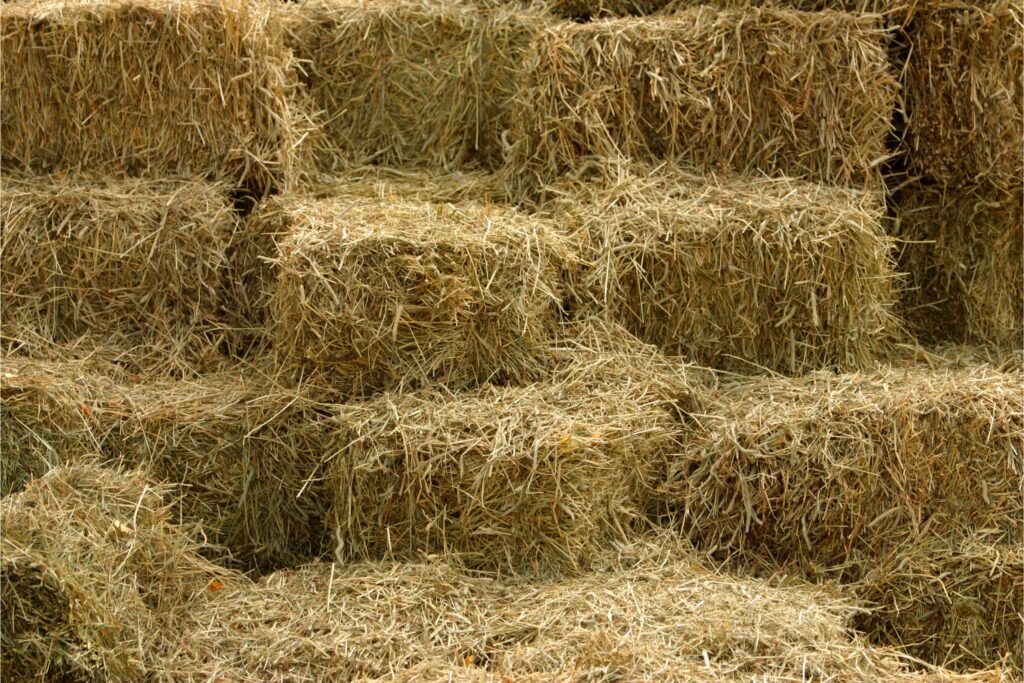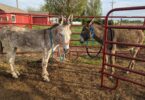Been there, stacked that!
If you’re a horse owner, you know that hay is a crucial part of your horse’s diet. But do you know which type of hay is best for your horse? Or how should hay be stored to prevent fire or mold?
In this blog, we’ll talk about the different types of hay bales and the nutrients found in each. We will also discuss hay safety, including how to prevent fires and identify moldy hay. Plus, read on for essential pointers on how to properly stack hay bales to prevent collapse.
Hay Basics
Although it may seem as if one bale of hay is the same as the next, hay is a surprisingly complex topic.
Different types of hay yield completely different nutrients.
Baling it into various sizes makes all the difference between whether you’ll need a tractor to feed it to your horses, or not.
Types of Hay
The nutrients provided from a mix of grazing in the pasture and feedings supplemental hay make up the foundation of a horse’s dietary needs. Hay offers energy and fiber to your horse’s diet, critical elements to overall health.
It’s therefore essential to have a basic understanding of the different types of hay.
- Hay falls into two basic categories: grass or legume. Each type will give your horse a slightly different mix of nutrients.
- Alfalfa hay falls into the legume category and contains around 14% protein. Grass hay, on the other hand, is approximately 8-10% protein.
- Horses at different stages of growth and activity levels require a diverse mix of nutrients. Grazing-related activities occupy anywhere from 9-16 hours of a horse’s daily life. Feeding a sedentary horse hay high in energy will result in undesirable weight gain.
- On the other hand, lactating mares and foals have high energy demands. Alfalfa or a legume and grass mix may be more appropriate in this situation.
Always consult your veterinarian or a specialist in equine nutrition for questions about your individual horse’s dietary needs.
Different Size Hay Bales
Aside from the nutritional content, hay bales differ significantly in their size.
Hay comes in small pellets, square bales, or large round bales weighing over 1,000 pounds.
Standard square bales weigh around 50 pounds. Large square bales weigh upwards of 100 pounds or more.

Small square bales. Photo Cred: Canva
Larger bale sizes require a tractor or skid steer to move them from place to place. But even smaller bales require a fair amount of strength to carry around.

Large square bales. Photo Cred: Canva
How to Store Hay
Hay should be stored well away from moisture. Bales should also be well-ventilated to prevent the build-up of excessive heat, which could spark (ok, spontaneous combustion) fires.
Always keep the space where you store hay as clean as possible. Once you’ve used up your supply, take some time to thoroughly clean the area and inspect for potential sources of moisture.
Do not stack your hay all the way to the roof. Instead, leave space for air to circulate. Hay should ideally be stored indoors to prevent access to moisture or vermin.
Safety Concerns when Stacking Hay
There are a few safety concerns to keep in mind when dealing with hay.
Mold
Moldy hay can cause colic, respiratory issues, and even the death of unborn foals. It is important to avoid feeding moldy hay to your horse. If you think your hay might be moldy, throw it out.
Issues caused by moldy hay are serious, so don’t risk your horse’s health!
Always make sure hay is completely dry before stacking and storing it. Wet hay can mean mold or even fire.
Fire
It sounds counterintuitive, but wet hay stored in a hot place is a significant fire hazard. Stacking hay too tightly is also asking for trouble.
Many people also stack hay on pellets to encourage airflow beneath the pile. This can also help with moisture control.
Stacking in a crisscross pattern with one layer facing a direction and the next layer loosely facing the opposite direction encourages airflow between the piles.
Hay fires spread rapidly and are very dangerous. Never try to tackle a fire on your own. And if you suspect a fire in your hay storage area, contact 911 immediately.
Store fire extinguishers near your hay, and never store flammable liquids nearby.
Stack Collapse
Stacking hay to promote airflow means that bales are not stacked tightly together. This can mean the possibility of a stack collapse.
Hay bales are heavy and, when they fall, can cause serious injury to anyone nearby.
You can ideally avoid stack collapse by keeping your stacks short and closely monitoring children while they are in the hay storage area. If you think the stack may be in danger of collapsing, clear the area immediately and seek help from others.
As with most things pertaining to horses, your safety is most important!

Square bales. Photo Cred: Canva
How to Stack Hay
Properly stacking your hay is the difference between several months of food for your horse or extra garden mulch. By sticking with a few simple rules, you can be assured that your money won’t be wasted.
Despite your best efforts, sometimes hay spontaneously catches on fire.
Storing your larger supply elsewhere reduces the risk that you’ll also lose your horse, or barn, if a fire does break out. And if you buy in bulk, consider storing your hay in a separate building away from your horses.
Airflow is Important
- Stack to promote airflow. Loose stacking of individual bales also promotes airflow between stacks. Again, never stack hay all the way to the ceiling.
- Make sure the place where you store hay also has ventilation in the form of cupolas or other vents.
- A lack of airflow increases your risk for mold and fire. If you’re new to hay handling, consider consulting a local farmer for extra pointers about proper hay storage.
Moisture – Bad for Hay
- Mold and moisture go hand-in-hand. As mold can cause significant health problems and even death for horses, it’s essential to protect your hay from moisture.
- Hay should ideally be stored indoors and away from moisture. It’s a good idea to check your roof for possible leaks to avoid moisture contaminating your fresh hay.
- And regularly check for signs of mold in your hay. Moldy hay is often darker than fresh hay. You should also smell the hay. If it smells musty or sour, it’s probably moldy and should be thrown out. Finally, feel the hay. If it’s damp or clumpy, it’s probably moldy, and you shouldn’t feed it to your horse.
Avoid Stacking in Sunlight
- Hay is flammable. If there’s any moisture in the center of the bale, adding heat increases the risk of spontaneous combustion. It’s therefore essential to avoid storing hay in direct sunlight.
- Additionally, chances are that if sunlight can hit the hay, so can moisture such as rain.
How to Stack Hay Securely
Stack hay with the cut side down. Stick with short stacks, if possible, to avoid collapse. And always stack on pallets to encourage airflow below the pile.
If you stack taller piles, know that the bottom layer will develop moisture. Always carefully inspect the bottom layer before feeding because it is highly likely to contain mold.
Consider using straps or support structures to stabilize the stack.
As you stack upwards, think about creating a pyramid-type design that starts out wider in the base and narrows as it builds upwards. This creates more stability and lessens the risk of a collapse.
Frequently Asked Questions
Q: How do you stack 100 bales of hay?
When stacking 100 bales of hay, you should build your stack carefully.
Avoid stacking the hay too high, and use straps or other support structures to keep the stack stable.
Inspect your hay stacks regularly for signs of weakness, and do not hesitate to call a professional if you are unsure of the stability of your stack.
Q: How do you stack hay to prevent mold?
Even before stacking, carefully examine the hay for signs of moisture. If there is moisture, allow the hay to completely dry in a well-ventilated area before stacking.
Stack hay in short stacks on pallets for your best shot at preventing mold.
Regularly assess your hay storage area for signs of possible moisture. And always inspect your hay for mold before feeding it to your horse.
Q: How do you stack hay to prevent fire?
Airflow is key to preventing fire. Never stack right up to the ceiling. And always leave room for airflow between and below the stack.
Q: How do you stack hay by hand?
Always wear steel toe boots such as cowboy boots while working with hay. Wearing jeans that go over your boots protects your legs from scratches.
Ideally, you should wear long sleeves and leather gloves to provide further protection from hay scratches.
If it is hot outside, drink plenty of water and take rest breaks.
Q: How do you keep hay bales together?
Careful stacking is typically enough to ensure hay bales stay together.
You can also use longer pieces of baler twine or even a ratchet strap if you need to add reinforcement.
Q: How long should hay sit before stacking?
There are certain moisture thresholds to pay attention to when the hay is initially baled.
Small square bales can hover between 15 and 22 percent moisture, while larger bales should be 18 percent at the most.
Bales with over 20 percent moisture have a higher risk of mold and spontaneous combustion. You can check the moisture content of your hay with a special hay moisture meter.
Q: Is stacking hay hard?
It can be! Even small square bales can weigh between 50 and 100 pounds. Lift a few of those, and you’ll be feeling it in the morning…
Parting Thoughts
Although there’s a lot to know about hay, mastering the basics can help you stay safe and your horse well-fed. And by paying attention to good hay storage practices, you can ensure your investment pays off rather than ending up as garden compost.
If you have questions about hay quality or which type is best for your horse, always consult a veterinarian or equine nutrition specialist. And for questions about hay handling or storage, consider consulting a local farmer. Your county agricultural extension office can also provide a wealth of information on various topics.
Good luck and happy haying!
P.S. Enjoy this article? Trot on over to:
- Horse Hay FAQs (Types of Hay and How to Feed It)
- Winter Hay 101: How Much to Feed Your Horse (And Why)
- Hay Bale Facts and Figures (Sizes, Types, Costs)
- How to Soak Hay for Horses (And Why Bother!)
- Winter Hay Feeding Quiz
- Happy Trails Gear Guide: What to Wear Horseback
Trail Riding - 6 Essential Supplies for Multidisciplinary Horse Riders
- Daily Horse Care Made Simple (Quick-Print Checklist)
Sources
- Horse Racing Sense
- University of Florida
- https://www.horizonstructures.com/blog/its-hay-season-are-you-playing-fire/
- Horse Racing Sense – Hay Bale Size
- Bosque County, Texas Extension Office







